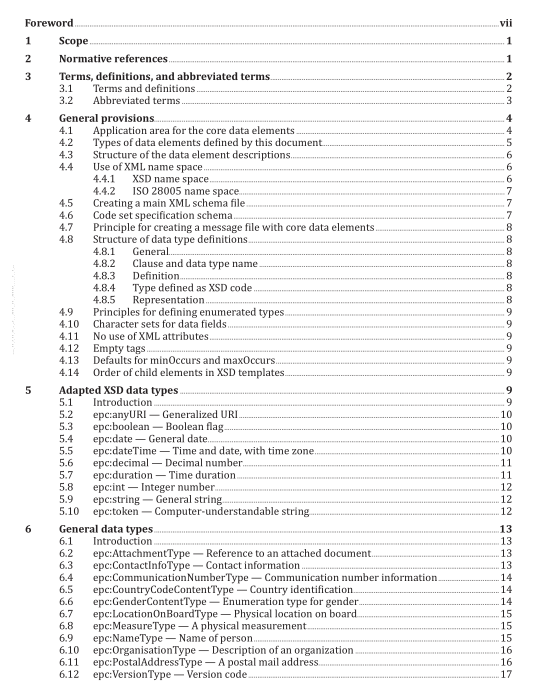ISO 28005-2:2021 pdf download.Ships and marine technology — Electronic port clearance (EPC) — Part 2: Core data elements
4.7 Principle for creating a message file with core data elements Clauses 5 to 7 of this document define data types that can be used to construct core data elements. Annex A defines how each core data element shall be defined from the data type. Any selection of core data elements can be used to generate an XML message for exchange of information between ship and shore. ISO 28005-1 specifies how the message shall be constructed and how messages are exchanged.
4.8 Structure of data type definitions
4.8.1 General Each data type is defined in a separate subclause, the structure of which is descibed in 4.8.2 to 4.8.5.
4.8.2 Clause and data type name All data types defined in this document are given a name that is also included as the first part of the heading for the subclause where the data type is defined. The data type name follows the specifications for XML tag names [15] , with the following additional constraints.
a) The name shall always end with the string “Type”.
NOTE 1 Some core data elements can also have the ending “Type”. In that case, the corresponding core data type has the postfix “TypeType”.
b) Enumerated data types shall have the postfix “ContentType”.
c) This document uses the “Upper Camel Case” in all core data types, i.e. the first letter is upper case and, when the tag name consists of a number of concatenated words, each of the words starts with an upper case letter. ) The name consists only of characters from the sets (A-Z), (a-z) and, exceptionally, (0-9). NOTE 2 The names have been selected to be generally understandable in the context of ship-to-shore communication for port clearance. The names are in normal British English without any special characters. Names are in singular form except where the data element contains a list of items, in which case the tag name is in plural form.
4.8.3 Definition Each data type has a definition that is intended to give an unambiguous description of what the data element shall contain and in what context it is valid. This is the first paragraph after the heading of the clause.
4.8.4Type defined as XSD code Each data type is defined as a section of XSD code. This section only covers the actual data type definition and is not a valid XML document in itself. Annex S gives a brief overview of the syntax elements used, but the user of this document should refer to Reference [16] for the definitive descriptions.
NOTE The XSD code has been generated automatically and, as the order of child elements in XSD is important and cannot arbitrarily be changed, the ordering in the XSD code is the generated order, and is not always logical.
4.8.5 Representation Additional information about how the data field shall be formatted is contained in the representation paragraph. This can give, for example, the normative reference to the official sources of enumeration codes.
4.9 Principles for defining enumerated types Enumerated types, i.e. types that are associated with a fixed set of code values, are defined in one of three ways.
a) When the code set is small, and not defined and maintained by parties external to this document, the allowed code values are listed in the definition of the data type as XSD constraints. NOTE 1 For an example of inline listing of enumerated types, see type definition for TimeTypeContentType in 6.13.
b) If the code set is larger, and not defined and maintained by parties external to this document, the code set is included in a normative annex, e.g. Annexes D to I.
NOTE 2 The definition of the enumerated types can use the same principle as described in item a) above or as an external file as described under item c).
c) When the code set is maintained by an external party, the data type only defines the data type as a token and makes a reference to where the code set can be found and how the code set shall be used in the core data element. An informative annex contains a list of some of the most common codes, e.g. Annexes J to N. Subclause 4.6 can be used to encode the values in XML or the code set can be included in an XSD file for direct validation of XML messages.ISO 28005-2 pdf download.ISO 28005-2 pdf download
